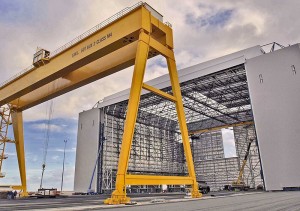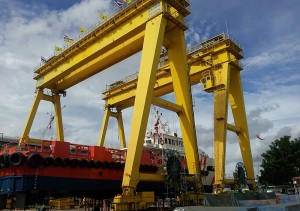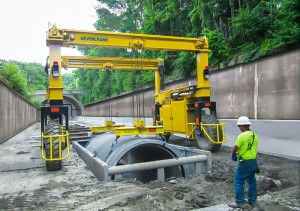
2 Ton Warehouse Gantry Crane for Sale
Product Details and Features
Lifting Capacity: A 2-ton gantry crane is specifically designed to handle loads weighing up to 2 tons or 2,000 kilograms. This capacity makes it suitable for lifting and moving various items within a warehouse, such as small machinery, parts, pallets, and other materials.
Span: The span of a gantry crane refers to the distance between the outer edges of the two supporting legs or uprights. For warehouse applications, the span of a 2-ton gantry crane can vary depending on the layout and size of the warehouse. It typically ranges from around 5 to 10 meters, although this can be customized based on specific requirements.
Height Under Beam: The height under beam is the vertical distance from the floor to the bottom of the horizontal beam or crossbeam. It’s an important specification to consider to ensure that the crane can clear the height of the items being lifted. The height under beam of a 2-ton gantry crane for a warehouse can be customized based on the intended application, but it typically ranges from around 3 to 5 meters.
Lifting Height: The lifting height of a 2-ton gantry crane refers to the maximum vertical distance it can lift a load. The lifting height can be customized based on the specific needs of the warehouse, but it typically ranges from around 3 to 6 meters. Higher lifting heights can be achieved by using additional lifting equipment, such as chain hoists or electric wire rope hoists.
Crane Movement: A 2-ton gantry crane for a warehouse is typically equipped with manual or electrically powered trolley and hoist mechanisms. These mechanisms allow for smooth and controlled horizontal movement along the gantry beam and vertical lifting and lowering of the load. Electric-powered gantry cranes offer greater convenience and ease of operation since they eliminate the need for manual effort.
Application
Warehouses and logistics centers: 2-ton gantry cranes are ideal for cargo handling and stacking operations in warehouses and logistics centers. They can be used to unload and load goods, lifting goods from trucks or vans into storage areas or racks.
Assembly lines and production lines: 2-ton gantry cranes can be used for material transport and handling on production lines and assembly lines. They move parts from one workstation to another, smoothing the production process.
Workshops and Factories: In workshop and factory environments, 2-ton gantry cranes can be used to move and install heavy equipment, mechanical components and process equipment. They can move equipment from one location to another within the factory, providing efficient material handling solutions.
Shipyards and shipyards: 2-ton gantry cranes can be used for ship construction and maintenance in shipyards and shipyards. They can be used to install and remove ship parts, equipment and cargo, as well as move the ship from one location to another.
Mines and Quarry: The 2 ton gantry crane can also play a role in mines and quarries. They can be used to move ore, stone and other heavy materials from excavation areas to storage or processing areas.







Product Process
Structure and materials: The structure of the 2-ton warehouse gantry crane is usually made of steel to provide strong support and stability. Key components such as uprights, beams and casters are often manufactured from high-strength steel to ensure safety and durability.
Control options: The operation of the 2-ton warehouse gantry crane can be controlled manually or electrically. Manual controls require the operator to use handles or buttons to control the movement and lifting of the crane. Electric control is generally more common, using an electric motor to drive the crane’s movement and lift, with the operator controlling it via push buttons or a remote control.
Safety devices: In order to ensure the safety of operation, 2-ton warehouse gantry cranes are usually equipped with a variety of safety devices. This may include limit switches, which control the crane’s raising and lowering range to prevent safety limits being exceeded. Other safety devices may include overload protection devices, power failure protection devices and emergency stop buttons, etc.














